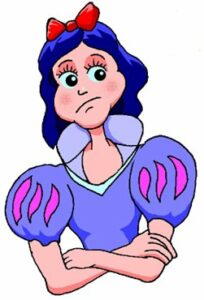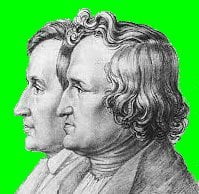
We all know the fairy tale Snow White, one that has been made into a pantomime. Snow White and the Seven Dwarfs is one of the most famous fairy tales in the world
As with all pantomimes, it is a story of good triumphing over evil.
It has it all:
- An innocent young beauty
- A vain, cruel, and jealous stepmother
- The innocent girl is to be killed
- She isn’t!
- She hides in the forest with seven lovable dwarfs
- She is kissed by a handsome prince
- It is true love
- She marries him and is happy ever after.
- Oh, and somewhere there is a poisoned apple
Our sister site Educational Musicals has created it as a Potty Panto Snow White & The Magnificent Seven
Click on Snow White & The Magnificent Seven

Naturally, in our Potty Panto, Snow White is, of course, beautiful and intelligent, and for that reason her jealous stepmother arranges to have her executed. This is where it changes. The executioner is a really nice guy, he just can’t kill her, he can’t do it so leaves her all alone in the spooky forest.
Now it becomes potty, our lost Snow White stumbles on a rundown log cabin with some unusual American cowboys. They are there because Snow White’s stepmother can’t stand Americans! So, she had the executioner take them out and behead them. Remember the executioner is really a nice guy so he took them deep into the forest and left them!
Meanwhile, once the wicked stepmother learns Snow White is still alive, she hatches a plan to get rid of her once and for all. Of course, after having the executioner executed!
As with all Educational Musicals shows we have purposely created it to be performed by children. Therefore, in the script no one has more than six lines in a row to learn unless they are narrating then it is scripted that they read the lines.
But where did it come from?
 The Grimm Brothers first told us the story in 1812. It first saw the light of day when they published Grimms’ Fairy Tales, which was originally called The Children’s and Household Tales. Many experts felt that all they had done was to gather together a series of old European folk stories. That may have been so, but weren’t they good stories?
The Grimm Brothers first told us the story in 1812. It first saw the light of day when they published Grimms’ Fairy Tales, which was originally called The Children’s and Household Tales. Many experts felt that all they had done was to gather together a series of old European folk stories. That may have been so, but weren’t they good stories?
So, was Snow White an original tale or was it a tale that had been passed down by word of mouth? It is said that Snow White and the Seven Dwarfs was a story that had even been around since the Middle Ages.
Was there a real Snow White?
Well, some people think so.
In 1994, a German historian, Eckhard Sander, published Snow White: Is It a Fairy Tale? He claimed that he had uncovered the story that may have inspired the Grimm brothers. He felt that the character of Snow White was based on the life of Margarete von Waldeck, a German countess born in 1533 because:
- At the age of 16, Margarete her stepmother, Katharina of Hatzfeld, forced her to move to Wildungen in Brussels.
- There, Margarete fell in love with a prince, who was heir to the throne of Spain.
- Margarete’s father and stepmother disapproved of the relationship, as it was “politically inconvenient”!
- Mysteriously she died at the age of 21, it is claimed she had been poisoned.
- It is claimed the King of Spain, who opposed the romance dispatched Spanish agents to murder Margarete.
What about the seven dwarfs?
- Margarete’s father owned copper mines employing children as quasi-slaves. The poor conditions meant that those who survived has their growth severely stunted, therefore, they were known as the ‘poor dwarfs’.
- The poisoned apple, comes from German history tells of an old man who was arrested for giving poisoned apples to children. He believed they were stealing his fruit!
An alternative suggestion – Maria Sophia von Erthal
Another theory comes from Lohr in Bavaria. They felt that Snow White is based on Maria Sophia von Erthal, born on June 15, 1729 in Lohr am Main, Bavaria.
- She was the daughter of 18th century landowner, Prince Philipp Christoph von Erthal and his wife, Baroness von Bettendorff.
- Again, when the Baroness died her father married Claudia Elisabeth Maria von Venningen, Countess of Reichenstein.
- It became clear that she disliked her stepchildren.
- In the castle was a ‘talking mirror’, an acoustical toy that could speak (it is now housed in the Spessart Museum).
- The mirror was made in 1720 by a local mirror manufacture and had been in the house during the time that Maria’s stepmother lived there.
- They reckoned that the dwarfs in the story were linked to a local mining town, Bieber.
- In the mine the smallest tunnels could only be accessed by very short miners, who often wore bright hoods. They looked like dwarfs.
- They felt the glass coffin was linked to the region’s famous glassworks.
- The poisoned apple, they thought was due to the deadly nightshade poison that grows in abundance in Lohr.
Both these stories show that we may never know where it originally came from. However, these various stories of Snow White all ended up as a story from the Grimm Brothers, one that has given us immense pleasure.
Does it really matter whether it has any historical basis, it is a famous fairy tale, and isn’t that great?
Enjoy the story and enjoy our Potty Panto Snow White & The Magnificent Seven and remember.
Panto is fun, and not just for Christmas!
10 Questions to discuss:
- What distinguishes the Potty Panto version of “Snow White and the Seven Dwarfs” from the traditional fairy tale?
- How does the role of the executioner differ in the Potty Panto adaptation compared to the original story?
- In what ways does the stepmother in the Potty Panto display her jealousy towards Snow White?
- Describe the encounter between Snow White and the American cowboys in the Potty Panto version. How does this interaction contribute to the story’s humor?
- How does the stepmother attempt to eliminate Snow White once she discovers she’s still alive in the Potty Panto adaptation?
- What unique feature characterizes the script of the Potty Panto to accommodate children performers?
- Who were the Grimm Brothers, and what was their contribution to the retelling of classic fairy tales like “Snow White and the Seven Dwarfs”?
- What evidence does German historian Eckhard Sander provide to suggest that Snow White may have been inspired by a real historical figure?
- Discuss the two proposed real-life inspirations for Snow White: Margarete von Waldeck and Maria Sophia von Erthal. How do their life stories parallel aspects of the fairy tale?
- Reflecting on the various theories surrounding the origins of Snow White, what does the author ultimately suggest about the importance of its historical basis?
For more on this go to:
https://elgiva.com/snow-white-history/
https://www.literacyworldwide.org/blog/literacy-now/2013/10/24/the-twisted-history-of-snow-white
© Tony Dalton

